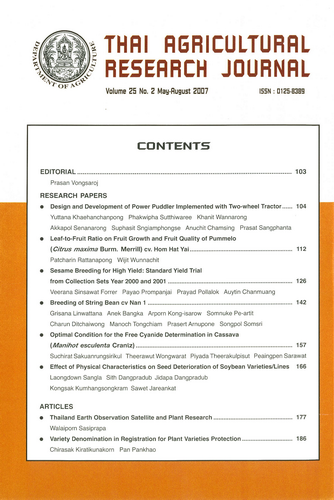Optimal Condition for the Free Cyanide Determination in Cassava (Manihot esculenta Crantz)
DOI:
https://doi.org/10.14456/thaidoa-agres.2007.12Keywords:
Enzmatic method cassava, cyanogenic glcoside, free cyanide, enzymatic methodAbstract
The cyanogenci glucoside in cassav is hydrolysed by endogenous linamarase to liberate cyanide which can directly be detected from the free cyanide determination, using enzymatic method. The aim of the present study was to determine the optimal condition for hydrolysis of cyanogenic glucoside in cassava. Varying amount of plant materials, different lengths of incubation time and three methods of preparation of plant materials were investigated. Tissues of cassava were sampled from freshly harvested 12-month-old cassava. The optimal condition for the determination of free cyanide content involved grinding young leaves (0.1 g) and cassava peel (0.3 g) in liquid nitrogen before adding the extraction buffer (pH 5.0) and incubating at 50 C for 60 minutes.
Downloads
Published
How to Cite
Issue
Section
License
Copyright (c) 2017 วารสารวิชาการเกษตร (Thai Agricultural Research Journal)

This work is licensed under a Creative Commons Attribution-NonCommercial-NoDerivatives 4.0 International License.
Thai Agricultural Research Journal


